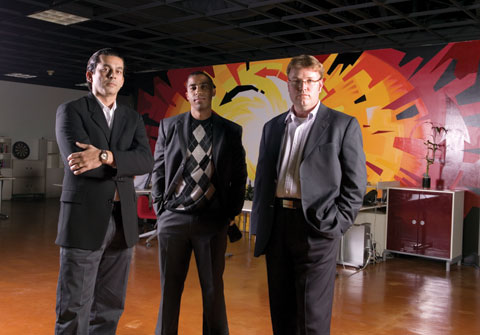3D renderings and animations, the often overlooked yet imperative aspects of developments, infuse visual vitality and lifestyle functions to an abstract idea. Here, we present a company whose sole purpose is to bring architecture to life.
By Kristelle Devieux
Spine3D has quickly become one of the leading 3D visualization studios in the United States and abroad.
Celebrated architect Frank Gehry once said, “I think my best skill as an architect is the achievement of hand-to-eye coordination. I am able to transfer a sketch into a model into the building.” This process of transferring a sketch into a building involves the agility of incorporating an art form with science.
With this millennium’s technological advances, many innovators have literally adopted and perfected Gehry’s words into a lucrative-and sometimes life-changing-service that fulfills practical as well as entertaining needs.
In 2002, a pioneering self-taught physicist, mathematician, and scientist named Alexander Tsiaras successfully merged the beauty of art and the science of health by developing mind-blowing 3D animations of human anatomy. A year later, in 2003, a small visionary Miami design firm, which was founded in 2000, upgraded and expanded its business into a full-fledged international corporation in response to growing demand and interest. That corporation is Spine3D, and its specialty lies in the creation of three-dimensional architectural renderings and animations.
Spine3D, the industry leader in architectural visualizations, has created award-winning renderings and cinematic animations for most of the country’s top real estate development projects. The company was established by three dedicated architects-Kevin M. Smith, Eddie Leon, and Johann Beckford-who met while working at design firm Spillis Candela DMJM. After creating and heading the advanced technologies division and playing major parts in the majority of the firm’s high profile projects, they quickly realized the growing demand for 3D visualization and the gap that needed to be filled. “Prior to Spine3D, large projects would rely on physical 3D models and hand-drawn watercolor illustrations to help pre-sell their idea to the masses,” explains Kevin M. Smith, the chairman/founder of Spine3D.
Primarily focusing on architecture, Spine3D also branched out to service building developers and advertising agencies with marketing tools. The company’s superior 3D renderings and animations help designers visualize 2D sketches, and allow architects and developers to make more informed decisions on materiality, form, color, and lighting. “Our team helps take a vision and realize it through compelling imagery and animation,” Smith explains.
With a keen sense in forecasting the demand’s growth, in 2003 the three partners decided to hire their own staff and expand into a full-fledged corporation in order to supply the national and international demand of 3D architectural visualizations. On the other hand, claiming esteemed attention and a Florida’s BEST award for their very first project, the move from a freelance organization to an international one was a no-brainer!
Now with 40 full-time employees, a headquarters in Miami and two branch offices, one in New York and the other in Shenzhen, China, Spine3D has quickly become one of the leading 3D visualization studios in the United States and abroad.
Touring Spine3D’s website feels like participating in a virtual world. The angles, detailed touches, surreal illustrations, along with the animations and accompanying soundtracks, literally transport the viewer into the developments Spine3D visually and sensually conveys.
Their work is of the same quality as the best animations found in video games and movies. Spine3D’s productions are made of an amalgamation of software packages to obtain supreme, quality imagery and animations. The process first entails the construction, texturizing, and lighting of the 3D subjects. Then, post-production effects by photo retouching artists and motion editors achieve the best quality of photorealism which is the stuff that makes it seem so, well, real.
To understand the time it takes from start to finish in completing a project, Johann Beckford, Spine3D’s chief operating officer, explains: “A project’s timeline can vary from one day to one year depending on multiple variables, like the information provided to us, if we are being contracted by the developer or architect to help in the design development phase, the marketing collaterals and deliverables needed, and the amount of edits we are given throughout the process.” All this is done in accordance with rigid deadlines, as Spine3D has developed a know-how that allows the completion of projects in a limited time frame with the desired quality level.
Nevertheless, no matter the variables, the contractor, or the deadline of the project, Beckford says the best projects to work on are the ones that provide a lot of creative freedom. When a client has confidence in the company’s work and gives Spine3D carte blanche, their creative juices flow! This is evidenced by the animation for the Paramount Bay development, a marvelous sequence of intricately angled scenery and animations that takes viewers on a mini-adventure while exploring the development, its offered amenities, and the lifestyle.
Concurrently, he also lets us in on the most challenging and complex project they’ve worked on: the preparation of 30 competition renderings for a large Kerzner International project in Singapore that just so happened to be designed by none other than Frank Gehry.
In order to perfect their renderings and satisfy client demand, Spine3D has recently launched a “Product Visualization” division that focuses on creating renderings and animations of building products such as furnishings, lighting fixtures, case goods, and appliances. So much attention and detail is given to these renderings that one would think the artists at Spine3D have also taken on the task of designing future residents’ interior living space.
Currently, Spine3D is engaged in a number of significant projects. One of note is an animation for MGM Mirage called CityCenter, a residential development with 1,200 feet of frontage on the Las Vegas Strip. “The MGM project CityCenter is probably the largest project we have worked on so far in terms of deliverables and the entities involved. The project is basically a city within a city located in the entertainment capital of the world,” boasts Johann Beckford. Additionally, they are working on two other large condo/hotel developments in Sin City: Echelon and Fontainebleau Las Vegas.
Still, there is so much dedication and passion in their work that Beckford isn’t capable of picking a favorite project, because every project is as much a challenge as it is rewarding. “They all have their moments of gratification,” he says. But the most heartwarming aspect is that the three partners remain very humbled with all the influential architects, consultants, and experts they’ve had the opportunity to collaborate with.
Though Eddie Leon, the president and CEO of the corporation, recognizes that they compete with thousands of small design/animation firms, the company’s capacity to produce large animation projects combined with the founders’ expertise, level of service, prices, speed, and responsiveness keeps Spine3D ahead of the competition. On top of everything, the China branch allows them to function as a virtual 24-hour shop.
So with all the expansion and projects taking up Spine3D’s time, the partners are very ambitious for the future.
“Following the metaphorical idea of the ‘spine’, we see our company as being flexible and adaptive to the changes in technology and the new services the market will demand in the coming years,” Smith says.
“The next step for Spine3D is to offer our clients more: more service, more quality, more technology, and more accessibility,” Leon is quick to add. “We are also considering opening another United States office on the West Coast to better serve our clients in those time zones.”
With such an open mind on future expansions and capabilities, we suggest you keep a close eye on Spine3D’s advancements.





















